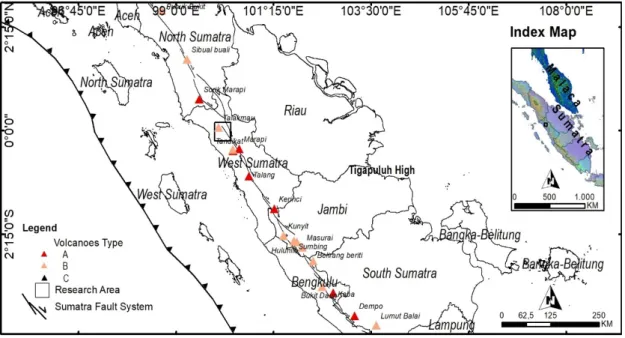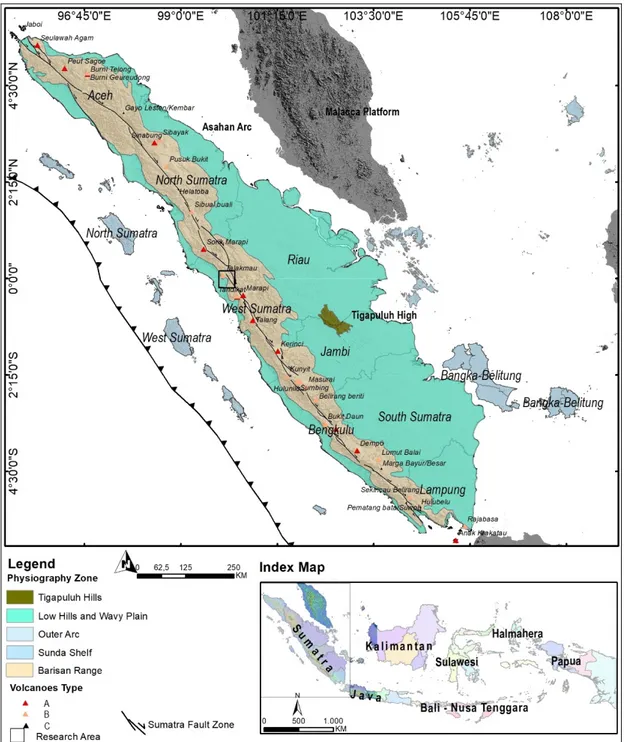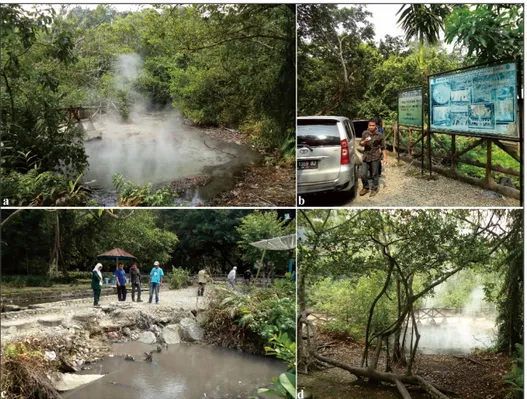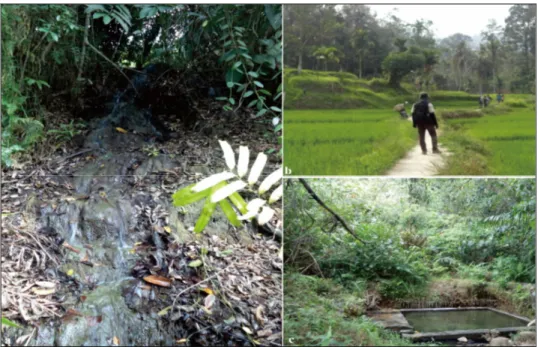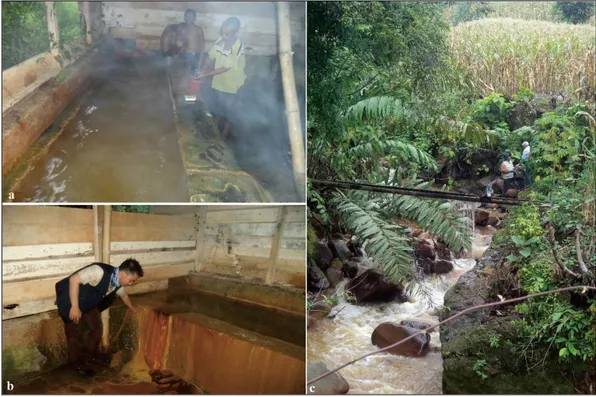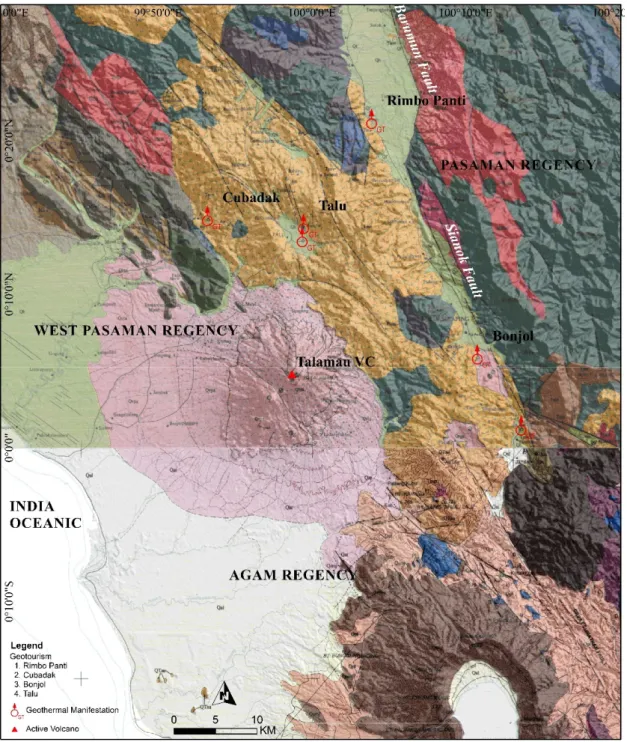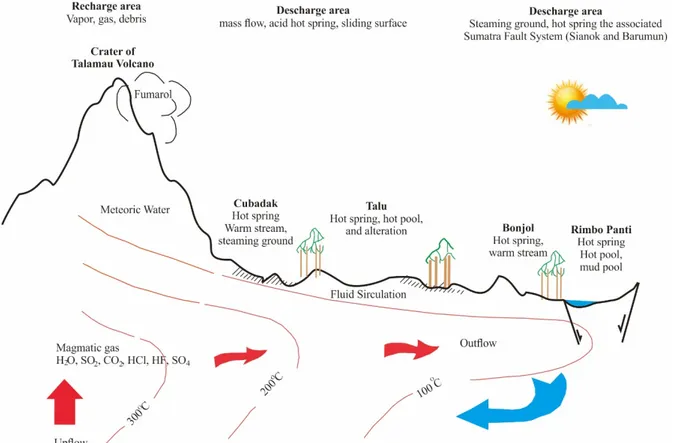GEOTHERMAL POTENTIAL ON SUMATRA FAULT
SYSTEM TO SUSTAINABLE GEOTOURISM IN WEST
SUMATRA
POTENSI PANAS BUMI PADA SISTEM SESAR SUMATRA
UNTUK GEOWISATA BERKELANJUTAN DI SUMATRA
BARAT
Hari Wiki Utama1*, Rahmi Mulyasari2, Yulia Morsa Said1
1Universitas Jambi; Jl. Lintas Jambi-Ma. Bulian No.KM. 15, Mendalo Darat, Kec. Jambi Luar Kota,
Kab. Muaro Jambi, Jambi, Indonesia
2Universitas Lampung; Jl. Prof. Dr. Ir. Sumantri Brojonegoro, No. 1, Gedong Meneng, Kec. Rajabasa,
Kota Bandar Lampung, Indonesia
Received: 2021, February 14th Accepted: 2021, June 24th
Keyword:
Geothermal potential; Sumatra fault system; Sustainable geotourism; West Sumatra.
Corespondent Email:
How to cite this article:
Utama, H.W., Mulyasari, R. and
Abstract. Sumatra Island is an island that is traversed an active ring of fire at
Barisan Range which is related to the active Sumatra fault system and geothermal manifestations. It is associated with geothermal manifestations in Cubadak, Talu, Bonjol, and Rimbo Panti, Pasaman Regency, and West Pasaman Regency, West Sumatra Province, as an indication of a geothermal system connected to the Sumatra Fault System from the Sianok Segment and the Talamau Volcano Complex. Sustainable geotourism has become effective for sustainable development of geotourism, the geothermal energy direct utilization. The purpose of this study is to provide sustainable geotourism from geothermal potential in the fault system, taking into account aspects of village geotourism, ecotourism, ecoculture, and education. The methodology used in this study is to collect data on geothermal manifestations from regional geological maps and field observations in geothermal manifestation areas by considering sustainable geotourism. A simple model of sustainable geotourism is made. Study results indicate several locations of potential geothermal manifestations to be used as sustainable geotourism associated with the Sumatra Fault System and the Talamau Volcano Complex.
Abstrak. Pulau Sumatra merupakan pulau yang dilalui oleh jalur gunung api
aktif pada Perbukitan Barisan yang berkaitan dengan keberadaan sistem sesar aktif Sumatra dan manifestasi panas bumi. Berhubungan dengan hal tersebut, terdapatnya potensi manifestasi panas bumi di Cubadak, Talu, Bonjol, dan
Said, Y.M. (2021). Geothermal Potential on Sumatra Fault System to Sustainable Geotourism in West Sumatra. Jurnal Geofisika Eksplorasi, 7(2), 126-137.
© 2021 JGE (Jurnal Geofisika Eksplorasi). This article is an open-access article distributed under the terms and conditions of the Creative Commons Attribution (CC BY NC)
Rimbo Panti, Kabupaten Pasaman dan Kabupaten Pasaman Barat, Provinsi Sumatra Barat sebagai petunjuk adanya sistem panas bumi yang terkoneksi dengan Sistem Sesar Sumatra dari Segmen Sianok dan Kompleks Gunung Api Talamau. Dengan tatanan geologi yang demikian, menjadi suatu hal yang sangat baik dijadikan sebagai tempat wisata alam kebumian yang berbasis geowisata berkelanjutan. Geowisata berkelanjutan menjadi suatu hal penting dalam peranan geowisata pembangunan berkelanjutan dari pemanfaatan secara langsung energi panas bumi. Tujuan dari studi ini diharapkan dapat menyediakan geowisata berkelanjutan dari potensi panas bumi di sistem sesar, dengan mempertimbangkan aspek geowisata desa, ekowisata, ekobudaya, dan eduwisata. Metodologi yang digunakan pada penelitian ini, yaitu mengumpulkan data manifestasi panas bumi dari peta geologi regional dan observasi lapangan di daerah manifestasi panas bumi dengan mempertimbangkan geowisata berkelanjutan, selanjutnya dilakukan pembuatan model sederhana dari geowisata berkelanjutan. Hasil dari penelitian menunjukkan beberapa lokasi manifestasi panasbumi yang potensial untuk dijadikan geowisata berkelanjutan yang berasosiasi dengan Sistem Sesar Sumatra dan Kompleks Gunung Api Talamau.
1. INTRODUCTION
A large part of Indonesia’s archipelago consists of islands is related to the active volcano of the Pacific ring of fire, including Sumatra of active continental margin (Entezari & Aghaeipour, 2014; N.T. Farsani et al., 2011; Neda Torabi Farsani et al., 2012; Hochstein & Sudarman, 2015). These have numerous implications for the existence of energy resource potential in Sumatra, particularly geothermal potential manifestation (Antić & Tomić, 2017; Hochstein & Sudarman, 2017).
Geothermal features manifestation on Cubadak, Talu, Bonjol, and Rimbo Panti, Pasaman Regency and West Pasaman Regency, West Sumatra, Indonesia are an indication to a geothermal system that connected to Sumatra Fault System (SFS) and Talamau Volcanic Complex (TVC) (Hermawan & Rezky, 2010; Hochstein & Sudarman, 2017; Sardjam et al., 2010) (Figure 1). It is significant for study the utilization of direct and direct use.
Geothermal energy potential is used for electricity and directly used geothermal energy as a tourism object. Geothermal features on Cubadak, Bonjol, Rimbo Panti, and Talu
associated with Sumatra Fault System have become interesting for sustainable geotourism on geothermal potential of tourism object.
Geotourism on geothermal energy is a natural tourism utilized to resource geothermal features potential, and linkage to geothermal landscape, lithology, structural geology, and historical geology. Geothermal geotourism implicates the study of an active volcano, geothermal landscape, and structural geology (Cooper, 2010; Prasetya et al., 2017; Suharcahyo et al., 2017).
Sumatra Fault System is an active structure associated with geothermal manifestation and volcanic of Barisan Range (Hall, 2011, 2012, 2013; Hall & Spakman, 2015; Muraoka et al., 2010). Neogene of counterbalancing the collision India Continental to Asia Continental, and activity continued to Quarternary volcanism. Sianok Segment and Barumun Segment are fault systems that appear of geothermal features manifestation potential on Rimbo Panti and Bonjol, where Talamau Volcanic Complex is part of the western Sumatra Fault System.
Sustainable geotourism has become significant for the sustainable development of geotourism. Organized geothermal geotourism will aid geothermal manifestation in potential geothermal education (Chen et al., 2015; Moufti & Nemeth, 2016; Utama, 2015; Utami et al., 2013). The purpose study is expected to provide significant sustainable geotourism of the geothermal potential fault system, regard several aspects, such as considering the geotourism village, ecotourism, ecocultural, and education based on local wisdom.
2. LITERATURE REVIEW
Sumatra is a part of Sundaland with numerous experienced tectonic; it is consist of Pre-Tertiary tectonic processes the early with the collision of East Sumatra to East Malaya Terrane on Mid-Permian, then a transitional system of East Sumatra Terrane to West Sumatra Terrane during Late Permian-Triassic, and terminated to obduction Woyla Arc to West Sumatra Terrane during Jurassic-Cretaceous (Metcalfe, 2011, 2013, 2017; Zahirovic et al., 2014, 2016). Pre-Tertiary tectonic is composed of stratigraphy and
structural geology in Sundaland. The preliminary Paleogene tectonic is Sumatra clockwise rotation which is formed of magmatic arc, volcanic arc, and volcanic sedimentary on Barisan Range and continued Neogen tectonic of Sumatra counterclockwise as the response of collision Australia to the eastern margin of Sundaland; it is a consequence of magmatic arc, volcanic arc, and active Sumatra Fault System on Barisan Range (Advokaat et al., 2018; Carey, 1955; Hutchison, 2010, 2014). Quarternary tectonic is related to an active volcano and geothermal features manifestation. The geological situation of Paleogene to Quatenary have experienced on Barisan Range the related to geothermal manifestation.
The physiography zone in Sumatra is divided into 1) Barisan Range related to geothermal and volcanic, 2) Sumatra Fault System-associated to volcanic and geothermal, 3) Tigapuluh Hills, 4) Sunda Shelf, 5) Low Hills and Wavy Plain, 6) Outer Arc (Utama et al., 2021). The geothermal features manifestation related to Sumatra Fault System (Figure 2).
Figure 1. Geothermal geotourism on Pasaman Regency and West Pasaman Regency, West Sumatra,
Indonesia. SFS and TVC are associated with geothermal potential to sustainable geotourism (modified from Hochstein & Sudarman, 2017).
3. METHODS
This paper explains the geothermal potential of the Sumatra Fault System for sustainable geotourism. The early study is indirectly geological mapping through the regional geological map with 1:250.000 scale map, then recognizing geothermal manifestation and fault system that supported digital elevation model Aster Gdem 30 m of overlapping to regional geological map, and then the accompanying geological analysis of geothermal manifestation for understanding characteristic geothermal features potential manifestation, which is associated to volcanic hydrothermal or volcano-tectonic. Its purpose is the sustainability of geothermal potential to geotourism (Antić & Tomić, 2017; Suharcahyo et al., 2017). The sustainability geotourism concept is very important for geothermal manifestation areas developed and utilized for tourism. Sumatra Fault System has numerous geothermal feature manifestation, therefore need sustainability geotourism which considering the geotourism village, eco-tourism, ecocultural, and edutourism.
Geological surface collecting data only geothermal manifestation potential from the geological investigation, several locations such as Bonjol, Cubadak, Talu, and Rimbo Panti on Pasaman Regency, West Sumatra. Geological and tourism analysis of the potential geothermal site comprehends the characteristics of geotourism village, ecotourism, ecocultural, and edutourism. The final integration to these data geological mapping determined geothermal manifestation potential to sustainable geotourism with simplified block model geotourism.
4. RESULTS AND DISCUSSION 4.1. Result
Geothermal potential in Bonjol, Cubadak, Talu, and Rimbo Panti on Pasaman Regency,
West Sumatra, has numerous geothermal manifestations to become geotourism sustain-ability, such as hot spring, hot pool, mud pool, steaming ground, and hydrothermal alteration rock. Below, the category of geothermal geotourism in West Pasaman Regency and Pasaman Regency, West Sumatra
.
4.1.1. Rimbo Panti Geotourism
Geothermal features manifestation consists of the hot pool, mud pool, hot spring, hydrothermal alteration rock. This location has made for tourism, but there is not yet a signboard as guidance for understanding the appearance of geothermal features, so that significantly for tourism object become sustainable geotourism with aspect education with a signboard about historical geothermal manifestation (Figure 3). Geothermal features manifestation on Sumatra Fault System, between of Barumun Segment and Sianok Segment. The existence of geothermal manifestation on Miosen hydrothermal alteration andesitic lava.
4.1.2. Bonjol Geotourism
Geothermal appear manifestation divided to the hot pool, hot spring, hydrothermal alteration rock, and stream to Bonjol River of irrigation (Figure 4). The existence of geothermal manifestation on Sianok Fault Segment. Detachment of bedrock as proof of the linkage geothermal feature manifestation to Sumatra Fault System. Public facilities such as mosques and gazebos can use tourism objects but have no signboard about education geothermal manifestation of the Quatenary volcanic product and Miosen lava.
4.1.3. Cubadak Geotourism
Geothermal manifestation on Cubadak is composed of warm stream, hot spring, hydrothermal alteration rock, and hot pool. This location is the northern part of the Talamau Volcanic Complex and the western part of the Sumatra Fault System.
The relevance for sustainable geotourism, so that signboard for a lesson to tourism in the
destination there, requires a signboard about the historical geology of existence geothermal features manifestation (Figure 5).
Manifes-tation appears on Miocene Volcanic Product such as andesitic lava and volcanic breccia.
Figure 3. Geothermal features manifestation on Rimbo Panti Geotourism consist of a)
hot pool and hot spring, b) welcome board to the geotourism, but there is not any education signboard, c) mud pool and small pool that can be used to boil an egg, d) bridge above mud pool.
Figure 4. a) The public facilities of gazebo on geothermal manifestation, b) hot pool and
Figure 5. a) Warm stream and hydrothermal alteration rock, b) public facilities form the
street to geothermal manifestation destination, c) hot pool for geotourism.
4.1.4. Talu Geotourism
Geothermal manifestation consists of mud pool, hot spring, warm stream, hydrothermal alteration rock. These geothermal features on Talu are the northern part of Talamau Volcanic Complex, the western part of Sumatra Fault System, and near Cubadak Geothermal manifestation (Figure 6). Holocene volcanic product and Miosen andesitic lava product is consist of lithology on geothermal manifestation. This location has not a signboard to describe the geothermal manifestation for tourism.
4.2. Discussion
Geothermal manifestation related to SFS of Sianok Segment and Barumun Segment and the associated to TVC. Appear of geothermal manifestation on the Rimbo Panti, Bonjol, Cubadak, and Talu are refer to as volcanic-tectonic (Figure 7). Geothermal manifestation is stratigraphy composed of Miosen andesitic lava and volcanic breccia (Tmv) and Quatenary Holocene volcanic (Qh and Qvgn) (Kastowo et al., 1996; Rock et al., 1983). Geological settings on the geotourism in these
areas have historical geology involve Quatenary volcanic activity of volcanic dormant type B of Talamau Volcanic Complex (See Figure 2) as the heat source of the geothermal system, whereas Sumatra Fault System as permeability zone of fracture system the channel way fluid geothermal the appear to surface as geothermal features manifestation.
Sustainable geotourism of geothermal manifestation requires local culture, including ecotourism and ecoculture, which is caring to local people and surrounding, environment conservation, traditional culture, and priority to entrepreneur. For applied the ecotourism, ecoculture, and geotourism village is required a signboard with a complete lesson about geothermal features manifestation, historical geology related to geothermal landscape, and structural geology as channel way of exposure/appear geothermal manifestation, to achieve education for tourists (Figure 8).
The conceptual model of geotourism is the perspective model of geotourism on Rimbo Panti, Bonjol, Cubadak, Talu, of Pasaman Regency and West Pasaman Regency, West Sumatra. It is to examine of geotourism village,
ecotourism, ecocultural, and edutourism. It is including of sustainable geotourism. Therefore, the recommendation of guidance of geotourism on potential geothermal sites in Sumatra is needed.
5. CONCLUSION
Geothermal manifestation on Rimbo Panti, Bonjol, Cubadak, and Talu, Pasaman Regency and West Pasaman Regency, West Sumatra consist of hot spring, mud pool, warm pool, hydrothermal rock alteration. Several locations of geothermal manifestation have made
natural tourism. Therefore, it is needed to examine the geotourism village, ecotourism, ecoculture, and education.
Geothermal potential on Sumatra Fault System of Sianok segment is significantly sustainable geotourism considering the environmental aspects, which are geotourism village, ecotourism, ecoculture, and education. The geotourism on Rimbo Panti, Bonjol, Cubadak, and Talu is required for sustainable geotourism based on local wisdom and a signboard of historical geology lessons.
Figure 6. a) Mud pool on warm pool shelter, b) warm pool shelter and hydrothermal alteration
Figure 7. Geological map of Pasaman and West Pasaman surrounding, modified after Rock et al. (1983)
on Lubuksikaping sheet geological map 1:250.000 and Kastowo et al. (1996) Padang sheet geological map 1:250.000. Geothermal site to geotourism situation on Rimbo Panti, Bonjol, Cubadak, Talu, Pasaman Regency, and West Pasaman Regency, West Sumatra. The geothermal manifestation appears on Miosen andesitic lava and volcanic breccia (Tmv) and Quatenary Holocene volcanic (Qh and Qvgn).
Figure 8. Simplified model of Geothermal Geotourism considers aspect utilization, including ecotourism,
ecoculture, geotourism village.
ACKNOWLEDGMENT
The study is a literature review, and geological field data have been taken from some geothermal locations on Rimbo Panti, Bonjol, Cubadak, and Talu. We want to send our gratitude to Allah SWT and to thank Geological Engineering, Faculty of Science and Technology, Universitas Jambi.
REFERENCES
Advokaat, E. L., Bongers, M. L. M., Rudyawan, A., Fadel, M. K. B., Langereis, C. G., & van Hinsbergen, D. J. J. (2018). Early Cretaceous origin of the Woyla Arc (Sumatra, Indonesia) on the Australian Plate. Earth and Planetery Science Letters, 498, Pp. 348-361.
Antić, A., & Tomić, N . ( 2017). Geoheritage and geotourism potential of the Homolje area (eastern Serbia). Acta Geoturistica, 8(2), 67–78. https:// econpapers.repec.org/RePEc:vrs:actgeo:v :8:y:2017:i:2:p:67-78:n:4
Carey, S. (1955). The Orocline Concept in Geotectonics- Part I. Papers and Proceedings of the Royal Society of Tasmania, 89, 255-288. Chen, A., Lu, Y., & Ng, Y. C. Y. (2015). The
Principle of Geotourism. Springer, 264.
Cooper, P. E. (2010). Geotourism in Volcanic and Geothermal Environments: Playing with Fire? Geoheritage, 187–193.
Entezari, M., & Aghaeipour, Y. (2014). Evaluation of Ecotourism and Geotourism Potential of Tourism Bisetoon by SWOT Method. Research and Urban Planning, 5(16), 75–88.
Farsani, N.T., Coelho, C., & Costa, C. (2011). Geotourism and Geoparks as Novel Strategies for Socio-economic Development in Rural Ar-eas. International Journal of Tourism Research, 13(1), 68–81.
Farsani, Neda Torabi, Coelho, C., & Costa, C. (2012). Geotourism and Geoparks as Gateways to Socio-cultural Sustainability in Qeshm Rural Areas, Iran. Asia Pacific Journal of Tourism
Research, 17(1), 30–48.
Hall, R. (2011). Australia–SE Asia collision: plate tectonics and crustal flow. The SE Asian Gateway: history and tectonics. Geological Society of London Special Publications, 355, 75– 109. https://doi.org/10.1144/SP355.5
Hall, R. (2012). Late Jurassic–Cenozoic reconstructions of the Indonesian region and the Indian Ocean. Tectonophysics, 570–571, 1– 41.
https://doi.org/https://doi.org/10.1016/j.tecto.20 12.04.021
Hall, R. (2013). The palaeogeography of Sundaland and Wallacea since the Late Jurassic. Journal of
Limnology, 72.
https://doi.org/10.4081/jlimnol.2013.s2.e1 Hall, R., & Spakman, W. (2015). Mantle structure
and tectonic history of SE Asia. Tectonophysics, 658. https://doi.org/10.1016/j.tecto.2015.07.003 Hermawan, D., & Rezky, Y. (2010). The Role of
Sumatera Fault Structures in Appearance of Geothermal Features at Cubadak Area, West Sumatera, Indonesia. Proceedings World Geothermal Congress, 1279–1281.
Hochstein, M., & Sudarman, S. (2015). Indonesian Volcanic Geothermal Systems.
Hochstein, M., & Sudarman, S. (2017). Indonesian Volcanic Geothermal Systems. Geothermische Energie Heft, 87, 20–22.
Hutchison, C. S. (2010). Oroclines and paleomagnetism in Borneo and South-East Asia. Tectonophysics, 496, 53–67.
Hutchison, C. S. (2014). Tectonic evolution of Southeast Asia. Bulletin of the Geological Society of Malaysia, 60, 1–18.
Kastowo, Leo, G. W., Gafoer, S., & Amin, T. C. (1996). Geological Map of Padang Quadrangle, Sumatra, Scale 1:250.000.
Metcalfe, I. (2011). Tectonic framework and Phanerozoic evolution of Sundaland. Gondwana Research - GONDWANA RES, 19, 3–21. https://doi.org/10.1016/j.gr.2010.02.016 Metcalfe, I. (2013). Gondwana dispersion and Asian
accretion: Tectonic and palaeogeographic evolution of eastern Tethys. Journal of Asian
Earth Sciences, 66, 1–33.
https://doi.org/10.1016/j.jseaes.2012.12.020 Metcalfe, I. (2017). Tectonic evolution of
Sundaland. Bulletin of the Geological Society of
Malaysia, 63, 27–60.
https://doi.org/10.7186/bgsm63201702
Moufti, M. R., & Nemeth, K. (2016). Geoheritage of Volcanic Harrats in Saudi Arabia; Geoheritage, Geopark, and Geotourism. Springer, 194. Muraoka, H., Takahashi, T., Sundhoro, H., Dwipa,
S., Soeda, Y., Momita, M., & Shimada, K. (2010). Geothermal systems constrained by the Sumatran fault and its pull-apart basin in Sumatra, Western Indonesia Proc. World Geothermal Congress, 2–8.
Prasetya, N., Lubis, D. E. U., Raharjo, D., Saptadji, N. M., & Pratama, H. B. (2017). Smart Geo-energy Village Development by Using Cascade Direct Use of Geothermal Energy in Bonjol, West Sumatera. IOP Conf. Series: Earth and Environmental Science, 1–14.
Rock, S., Aldiss, D. T., Aspden, J. A., M.C.G., C., & Djunuddin, A. (1983). Geological Map of Lubuksikaping Quadrangle, Sumatra, Scale 1:250.000.
Sardjam, B., Munandar, A., & Widodo, S. (2010). Geothermal System in Bonjol Geothermal Prospect, Pasaman Regency, West Sumatra, Indonesia. Proceedings World Geothermal Congress, 1183–1190.
Suharcahyo, K. N., Purnomo, H., & Setiawan. (2017). Geothermal Hot Water Potential at Parangwedang, Parangtritis, Bantul, Yogyakarta as Main Support of Geotourism. MATEC Web of Conferences. 101, 1–5.
Utama, H. W. (2015). Kendala Kegiatan Eksplorasi dan Pengembangan Energi Panas bumi sebagai Energi Terbarukan di Indonesia. In Sendipa, Bandung: Institut Teknologi Bandung.
Utama, H. W., Said, Y. M., Ritonga, D. M. M., & Kurniantoro, E. (2021). Geodynamics Relationship of Sabak Backarc Volcanic and Geragai Geothermal Features, Tanjabtim, Jambi, Indonesia. OIP Conferences International Press, 13.
Utami, P., Khasani, Warmada, I, W., & Wijaya, S. Y. C. (2013). Berwisata dan Belajar Tentang Energi Panas Bumi di Lahendong (1st ed.). Pustaka Geo (Smartania Publishing Group) dan Pusat Penelitian Panas Bumi Fakultas Teknik Universitas Gadjah Mada.
Zahirovic, S., Matthews, K. J., Falment, N., Muller, R. D., Hill, K. C., Seton, M., & Gurnis, M.
(2016). Tectonic evolution and deep mantle structure of the eastern Tethys since the latest Jurassic. Earth Sci. Rev, 162, 293–337.
Zahirovic, S., Seton, M., & Muller, R. (2014). The Cretaceous and Cenozoic Tectonic Evolution of Southeast Asia. Solid Earth, 5, 227–235.
